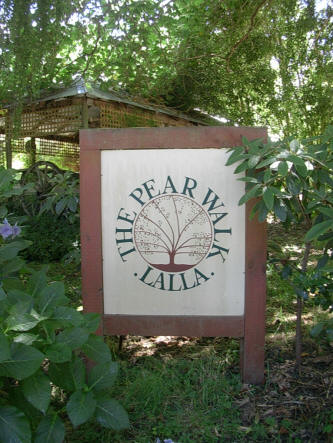|
A Short
History of the Pear Walk
|
 |
The property was acquired in 1892 by Mr. Frank Walker, a
plantsman who was trained at Kew Gardens. He planted
orchards and expanded the acreage to encompass an orchard
(at one stage over 90 acres was under fruit) where he grew
not only fruit trees but flowers for cutting and shrubs for
sale. When he acquired exotic plants, they were grown under
special conditions to acclimatize them to local conditions.
They were then sold. The business was thriving at its
height. Fruit output reached 16,000 cases in one season.
When work in the orchard slowed, Mr. Walker kept workers
busy by planting the Pear Arch and the Arbour Walk.
Now reduced to
thirty acres, the two walks still stand although they have
both been sadly neglected. Bruce and Libby Goodsir revived
the Pear Arch, which was featured in Australian Garden
Design in 1987, but the Arbour Walk remained too daunting a
task. The present owners are hoping to restore both walks
to their former beauty and have opened the Arbour Walk which
had been neglected for some forty years.
A new Laburnum
Walk and a has been planted and this is now part of a
parkland garden which is being cultivated to include the
existing house, built circa 1890, and two cottages built for
country accommodation in the 1980?s. |
Trees & Shrubs of Significance
in The Pear Walk Gardens
The Pear
Arch
Pyrus
Rosaceae
Two types of pear
tree were planted in the Pear Arch - KeIffer's Hybrid while
not self-pollinating, was considered one of the best canning
pears, and it was mixed with Beurre Clirgeau.
The original
planting of the walk, done in about 1906, was of 24 trees on
each side of the arch, twenty feet apart. On each side of
the arch, a space of four feet in width was devoted to the
growing of Ghent (mollis azaleas),Rhododendrons and Japanese
maples (Acer japonicum). At one end of the walk are two
copper beeches (Fagus ?Dawyck Purple?). At the other are
two recently planted paeony camellias ?Dixie Knight?.
A mixture of
bulbs can also be found, mostly of the narcissus family and
some Kalmia (Ericacea) Latifolia, which were part of the
original planting. New pear trees are being planted to
replace those that have succumbed to age.
The
Arbour Walk
Beginning at two
enormous Cryptomeria japonica Taxodiaceae, this walk is not
for the faint-hearted. Gumboots are needed to appreciate
the full extent of this feature which ends at a natural
spring that was here long before the original purchase of
the property. Large Cyathea Dicksonia Antarctica still stand
and the walk has been planted with some magnificent tree
specimens. A huge Liriodendron has grown amidst
rhododendrons, camellias, birches flowering cherries,
wisteria and flowering gums, pussy willow and Styrax. This
walk is as long as the Pear Walk but with a completely
different ambiance. Work is in progress and many more hours
are needed to restore this feature.
Names of
plants on the Property
Aesculus hippocastanaceae
Alnus
Araucaria araucana
Azalea
Betula ?
nigra, pendula, papyrifera
Prunus
Beurre clirgot
Camellia species
Cedrus
Atlantica
Cedrus
Deodar
Chamycaparus japonica
Cornus
Corylus
betulaceae
Davidia
cornaceae,davidiaceae
Deutzia
Dicksonia
Antarctica
Diospyros kaki
Echium
Eriostemon
Escallonia
Fagus
Fraxinus
Grevillea
Iris
japonica
Kalmia Latifolia
Kolwitzia Amabilis
Laburnum Vossii
Lavandula
Laminaceae
Linum -
Phormium tenax grandiflorum
Liriodendron
Magnolia
Grandiflora, M. Stellata
Malus
Floribunda
Ioensis
Mayflower
Melianthus major
Metasequoia
glyptostroboides
Paeony
Perscus
Pieris japonica
Platanus
hispanica acerifolia
Prunus
Prunus
dulcis
Pyrus
Pyrus
Comminalus
Pyrus
Salcifolia
Quercus
robur
Quercus
rubra
Quercus
agrifolia
Quercus
coccinea,
Quercus
velutina
|
Rhododendron
Alison Johnstone
Augustinii
Blue Diamond
Blue Peter
Boulters cream
Callista
Christmas Cheer
Cilpinense
Cunningham?s white
Cunningham's White
Daviessii
Fastuosum Flora Pleno
Fastuosum Flora Pleno
Flora Pleno
Floral Dance
Fragrantisima
Ioensis
Kirin
Lem's Cameo
Lochieae
Macabeanum
Mt Everest
Mrs. Furnival's Daughter
Nancy Evans
Nutallii
Odee WrIght
Orbiculare
Pink Pearl
Saffron Queen
Sappho
Sylvatica
Temple Belle
Unique
White Pearl
Winsome
Romneya
coulteri
Roses
?Constance Spry? etc.
Thymus
Trachycarpus Fortuneii
Ulmus
hollandica, procera, parvifolia, Dicksonii
Viburnum
burkwoodii, macrocephalum, tinus, carlesii
Juglans
Acacia
longifolia
Wellingtonia gigantea (planted
in 1904, in 1929 it was 4 feet in diameter and 60
feet high.)
Cedrus
atlantica, deodara
Sequoia
sempervirens
Sequoiadendron
giganteum,
Thuja plicatSituated on the wine
route in the middle of nowhere
|
|